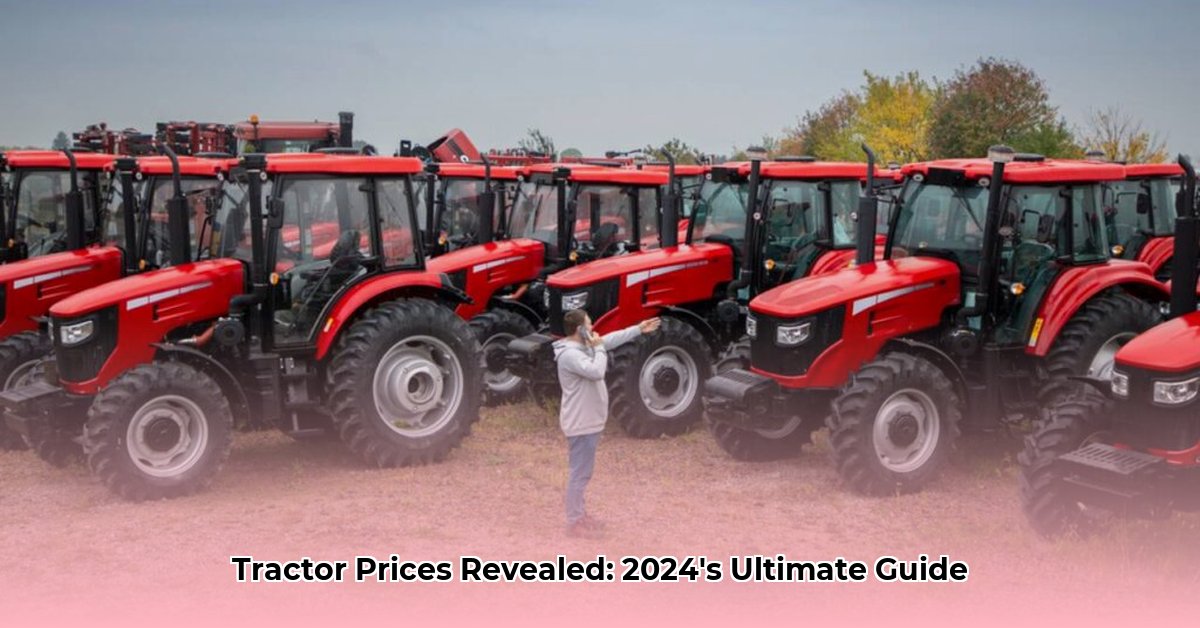
Buying a farm tractor is a significant investment. This comprehensive guide provides a detailed breakdown of tractor costs in 2024, helping you navigate the purchase process effectively. We'll explore key factors influencing price, financing options, and strategies for minimizing risk. For insights into the value of older models, check out this resource on used tractor values.
Tractor Power and Size: The Major Price Drivers
The most significant factor determining a farm tractor's price is its horsepower (HP) and size. Similar to automobiles, a smaller tractor (under 30 HP) suitable for smaller operations might cost less than $10,000. In contrast, a high-powered tractor (over 100 HP) used for large-scale farming can easily exceed $600,000. The greater the power and features required, the higher the cost. This directly impacts your operational capacity and budget. Do you need the power of a large tractor, or would a smaller, more affordable model suffice?
Age and Condition: The Used Tractor Market
The age and condition of a used tractor heavily influence its price. A newer tractor with low operating hours commands a significantly higher price than an older, well-used model. Consider the availability and cost of parts for older models; repairs can be expensive. A newer, well-maintained tractor might appear more expensive upfront but could lead to lower long-term maintenance costs. How much can you allocate towards repairs and maintenance?
Attachments: Adding Functionality and Cost
Attachments significantly increase the overall cost. A front-end loader might add $3,000-$6,000, while a backhoe could add another $4,500-$7,000. While these attachments enhance functionality, it's crucial to budget for their added expense. Do you need all the attachments available, or can you start with essential components and add more later?
Financing Your Tractor Purchase: Exploring Options
Financing is a viable option to make the purchase more manageable. Dealerships, banks, and government programs offer various financing plans. Compare interest rates, loan terms, and repayment schedules to find the most suitable option. How will financing affect your overall costs and long-term financial health?
Future Trends: Technology's Influence on Tractor Costs
Technological advancements continuously impact tractor costs and efficiency. Tractors with advanced features like GPS guidance or automatic steering systems might be more expensive upfront but can increase efficiency and reduce operational costs over time. What level of technological advancement aligns with your budget and long-term farming strategy?
Actionable Steps for Buying a Farm Tractor
Successfully purchasing a tractor involves a strategic approach:
- Define Needs: Determine the necessary HP and size based on your specific farming operations.
- Set a Budget: Consider the tractor price, attachments, financing costs, maintenance, and potential repair expenses.
- Compare Models: Research different brands and specifications, considering features, reliability, fuel efficiency, and maintenance requirements. Consult experienced farmers for their insights.
- Explore Financing: Compare options from dealers, banks, and government programs, focusing on interest rates, terms, and any special offers.
- Thorough Inspection (Used Tractors): For used tractors, a comprehensive inspection is crucial to identify potential issues and negotiate a fair price.
Assessing Risks: Mitigating Potential Problems
Significant risks need careful consideration:
| Risk Factor | Low Risk | Medium Risk | High Risk |
|---|---|---|---|
| Tractor Age | New or nearly new, low hours of use | Older, some wear and tear | Very old, significant wear and tear, limited parts |
| Financing | Low interest rate, good credit score | Higher interest rate, average credit score | High interest rates, poor credit, loan denial |
| Attachment Reliability | Reputable brands with warranties | Lesser-known brands, limited warranties | Unknown brands, no warranty, potential for frequent failures |
| Technological Advancements | Tractor with standard features | Tractor with some newer features | Older technology that could soon become obsolete |
Thorough planning, research, and due diligence are crucial for a successful and financially sound tractor purchase. This guide helps you make informed decisions, mitigating financial uncertainties and long-term risks.
Securing Financing for a High-Horsepower Agricultural Tractor
Financing a high-horsepower tractor requires a strategic approach:
- Traditional Lenders: Banks and credit unions offer varying loan products, often requiring good credit and collateral.
- Government Programs: Agencies like the Farm Service Agency (FSA) in the US offer subsidized interest rates and loan guarantees, but specific eligibility criteria apply.
- Online Lenders: Offer speed and convenience but often charge higher interest rates.
Choose the loan type carefully (secured vs. unsecured) and consider repayment schedules. A strong financial plan, showcasing farm profitability and the tractor's role in increasing efficiency, strengthens your application. Understanding the risks associated with high-interest rates and loan defaults is vital for long-term financial health.
Key Takeaways:
- Creditworthiness and a solid financial plan are essential for securing financing.
- Multiple financing options exist; carefully compare them.
- A thorough understanding of loan terms is crucial to avoid financial strain.
Green Box Capital: Everything You Need to Know About Farm Equipment Loans